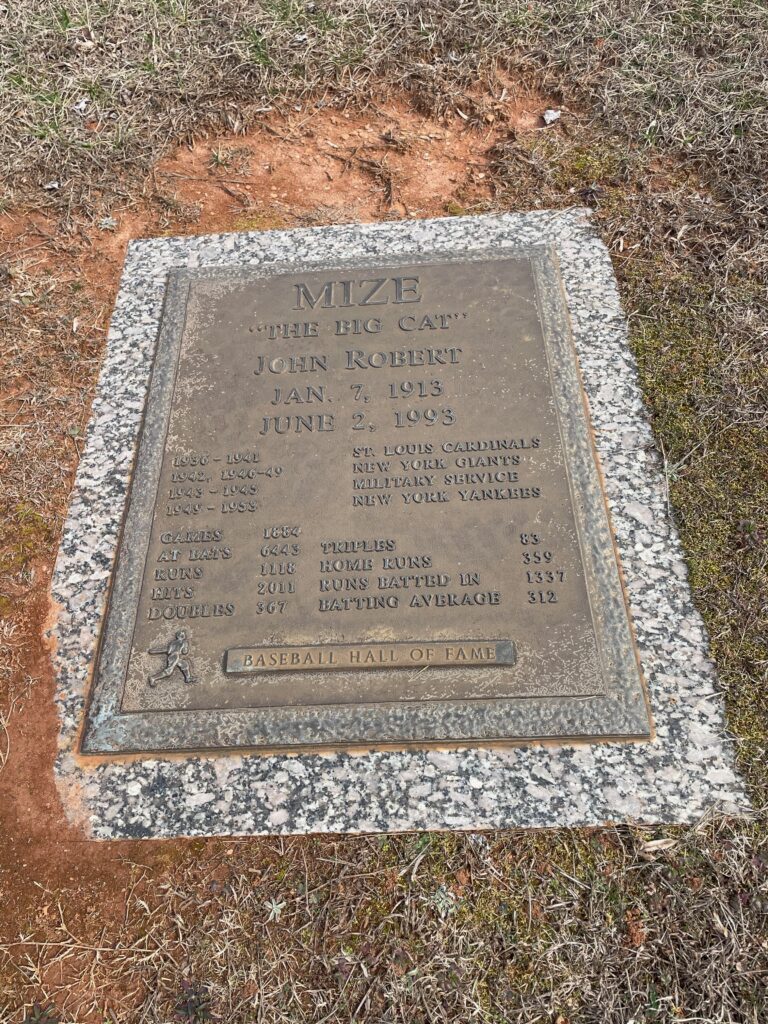Erik Visits an American Grave, Part 1,590
This is the grave of Johnny Mize.

Born in 1913 in Demorest, Georgia, Mize didn’t have the easiest childhood. His parents split up when he was a kid, then his mom bailed on him, moving to Atlanta for work while his grandmother raised him. Well, for whatever issues he might have had, the baseball diamond proved a good place to forget about them, especially because he was kinda good at the whole hitting deal. He played a bit at Piedmont College and then signed with the St. Louis Cardinals.
In 1934, while he was still in the minors, Mize hurt his leg and then the Cardinals traded him to the Cincinnati Reds. But immediately upon the trade, he got hurt again and the Reds cancelled the trade. In fact, in 1935, Mize was hurt yet again and he briefly retired entirely. But the Cardinals convinced him to come to St. Louis and see better doctors. Turns out it was bone spurs. Once he had surgery to fix those, things turned around pretty quickly.
Somewhat amusingly, because the Cardinals kept Mize around St. Lous for his treatment, they realized he was a much better hitter than they ever thought he was in the minors. So in 1936, they called him to the major league roster to pinch hit and then he immediately started to dominate. As Mize himself later said, “I’m the only guy who played in the major leagues because I couldn’t play in the minors.”
It didn’t take long for the Big Cat to become a force. His rookie year he hit .329/402/577 with 19 homers in 414 at bats. That’s pretty damn good for a rookie. The next year was even better. He hit .364/427/595 with 25 homers, got his first All-Star appearance, and finished 10th in MVP voting. He was second in the league in batting average that year too, only behind his teammate Joe Medwick. In both 1939 and 1940, he was second in MVP voting and he was absolutely great in both years. According to Baseball Reference’s WAR stat, he led the league both years, with 7.6 in 1939 and 7.5 in 1940. That’s MVP level, or very close to it. He led the NL in homers both years too.
Now, the Cardinals had a strategy that they stuck to. Branch Rickey was GM at that time and he believed in trading players at the very top of their value. I get that, but how do you actually replace Johnny Mize? In any case, after the 1941 season, where I guess you could say Mize showed a slight sign of decline, though you could argue it was a tiny blip too, they moved him to the Giants for Bill Lohrman, Johnny McCarthy, and Ken O’Dea. Those guys were all OK, but the Giants completed fleeced the Cardinals here.
Mize played with the Giants in 1942 and had a solid season, though maybe not his very best. He still lead the league in RBIs and slugging percentage and if that’s a whatever season, well, OK. But after that season, Mize was drafted into the Navy and he missed the next three seasons. Being a big baseball star, he really didn’t have to fight and so he didn’t. He was involved in training new soldiers and also playing for the Navy baseball teams.
Mize returned to the Giants in 1946 and showed very quickly that his bat was still very good. He only played in 101 games due to a broken toe, but he still finished second in the NL in homers. Then in 1947, he had his greatest power season ever, leading the league with 51 homers and 138 RBIs, finishing 3rd in MVP voting. Things did start slipping finally in 1949. He was reduced to a part-time role. He didn’t like that, asked for a trade, and was moved to the Yankees. He would play there for the rest of his career, which ended with the 1953 season. He never did return as a full-time player, but he still had a big power bat, including hitting three home runs in the 1952 World Series.
Mize retired after the 1953 season, realizing he was 40 years old and declining and didn’t want to stay around until he was an embarrassment. He stayed around the game for quite awhile, working both on the radio and as a scout for the Giants from 1955 to 1960. He also coached for the As in 1961.
Interestingly, despite being a pretty fantastic and popular player, he had to wait for the Veterans Committee to come calling for him to get into the Hall of Fame. He never received more than 43 percent of the vote on the main ballot. That Hall call finally came in 1981. By this time, he was mostly living in St. Augustine, Florida, though he went back home to his Georgia small town toward the end of his life. He died in 1993, at the age of 80.
Johnny Mize is buried in Yonah Memorial Gardens, Demorest, Georgia.
According to Baseball Reference’s JAWS stat, Mize is the 9th best first baseman of all time. If you would like this series to visit other first baseman, you can donate to cover the required expenses here. Roger Connor, the 19th century player who still ranks 5th all time, is in Waterbury, Connecticut. The great Hank Greenberg, who is 19th all time, is in Los Angeles. For modern context, Albert Pujols is 2nd, Jeff Bagwell 6th, Frank Thomas 8th, Jim Thome 10th, and Miguel Cabrera 11th. Previous posts in this series are archived here and here.
Also, welcome to baseball season!


